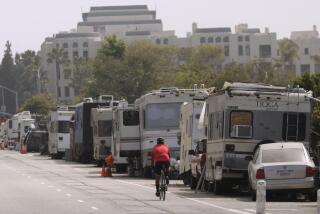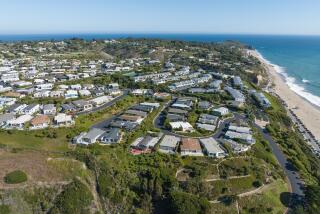Park Residents Finally Let It Go
By day’s end Wednesday, there was little left at the El Morro Village mobile home park besides vacant trailers and makeshift memorials of sprawled lawn chairs and sun umbrellas.
But on a bluff overlooking the Pacific Ocean, about 50 of the last tenants stood together. They cheered, wiped away tears and raised their glasses to the setting sun.
“This was a place where if you were rich, poor, young or old, you just got along with everybody,” said Bryan Wallace, 36, of Dana Point, whose family lived there summers and weekends since he was a child. “This has been hard for me and my family to say goodbye.”
State park rangers were at Crystal Cove State Park for the final hours. They planned to chain off the parking lot, shut off utilities and close the mobile home park for good at midnight. Any stragglers faced trespassing charges, state officials said.
By fall, the enclave tucked into a hillside between Corona del Mar and Laguna Beach will begin to take shape as a public campground, RV park and a sandy beach unencumbered by trailers. It is due to open by 2008.
Officials were confident that the midnight transfer would mark the close of a 26-year tug of war between the state and park residents, many of whom grew up there and passed the homes from generation to generation.
Taxpayers paid the Irvine Co. $32.5 million in 1978 for the land that stretches 3.5 miles along the Orange County coastline. Those in mobile homes at the southern end of the site were given 20-year leases, then five-year extensions in 1999.
Residents continued to fight, but Wednesday the battle drew to a close.
There was sadness, but there was also quiet celebration by those who had waited, hoped and fought for the day the state would empty the mobile home park.
As longtime residents fought the state’s eviction, protecting their million-dollar ocean views with lease extensions, environmentalists and others fumed.
“A lot of the media has been sympathetic to the residents,” said Fern Pirkle, a spokeswoman for Friends of Newport Coast, a group that supported the conversion. “But I’m sorry; it seems it’s very selfish of them to have held on to those leases while we, the taxpayers, have waited so long.”
State park officials said the new campground, with 62 campsites, is needed to meet demand for public use, said Roy Stearns, a state park spokesman.
“Instead of having this private enclave, which was good to these people, it will be open to all Californians to enjoy this beautiful stretch of beach,” he said.
Most of the nearly 300 residents had already left by Wednesday, saying farewells to neighbors of this tightknit community over the weekend.
Some left behind scrawled messages on vacant trailers: “We Will Always Remember El Morro and The Gov’t That Destroyed It” and “Hell No We Won’t Go.”
The destruction of the park will be particularly hard on Dale Neuman, a contractor who lived in the village for more than four decades and estimated he had done repairs on nearly three-quarters of the homes.
“I’ve got so many memories of this place,” said Neuman, 56, who is moving to San Juan Capistrano. “These people I’ve known all my life.”
Rolly Pulaski, El Morro Village park president, did what he thought would be a fitting goodbye. He threw a party.
“This has been bittersweet,” he said. “Many of us have cried and been sad. But we said goodbye to the final sunset in the right way.”
More to Read
Sign up for Essential California
The most important California stories and recommendations in your inbox every morning.
You may occasionally receive promotional content from the Los Angeles Times.










